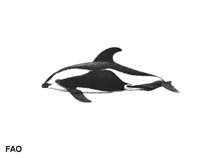Lagenorhynchus cruciger (Quoy & Gaimard, 1824)
Hourglass dolphin| Native range | All suitable habitat | Point map | Year 2050 |

|
| This map was computer-generated and has not yet been reviewed. |
| Lagenorhynchus cruciger AquaMaps Data sources: GBIF OBIS |
Classification / Names Common names | Synonyms | CoL | ITIS | WoRMS
Mammalia | Cetartiodactyla | Delphinidae
Environment: milieu / climate zone / depth range / distribution range Ecology
Pelagic. Polar; 0°N - 90°S, 180°W - 180°E
Distribution Countries | FAO areas | Ecosystems | Occurrences | Introductions
Indo-Pacific, Atlantic Ocean and the Antarctic: Antarctica and Kerguelen.
Length at first maturity / Size / Weight / Age
Maturity: Lm ? range ? - ? cm Max length : 163 cm TL male/unsexed; (Ref. 1394); 183 cm TL (female)
Sightings have been made in waters of 200 m or less, near islands and banks; ranges to the ice-edges in the south, but the northern limits are not known. Feeds on small fish (Ref. 1394). Sightings have been made in waters of 200 m or less, near islands and banks; ranges to the ice-edges in the south, but the northern limits are not known. Feeds on small fish (Ref. 1394).
Life cycle and mating behavior Maturity | Reproduction | Spawning | Eggs | Fecundity | Larvae
Main reference
References | Coordinator | Collaborators
Jefferson, T.A., S. Leatherwood and M.A. Webber. 1993. (Ref. 1394)
IUCN Red List Status (Ref. 130435)
Least Concern (LC) ; Date assessed: 18 March 2018
CITES status (Ref. 108899)
Appendix II: International trade monitored
CMS (Ref. 116361)
Not Evaluated
Threat to humans
Human uses
Fisheries: commercial
FAO - Fisheries: species profile | FishSource | Sea Around Us
Tools
More information
Age/Size
Growth
Length-weight
Length-length
Morphology
Larvae
Abundance
Growth
Length-weight
Length-length
Morphology
Larvae
Abundance
Internet sources
BHL | BOLD Systems | CISTI | DiscoverLife | FAO(Fisheries: species profile; publication : search) | Fishipedia | GenBank (genome, nucleotide) | GloBI | Gomexsi | Google Books | Google Scholar | Google | PubMed | Tree of Life | Wikipedia (Go, Search) | Zoological Record
Estimates based on models
Preferred temperature
(Ref. 115969): 0.1 - 2, mean 0.9 (based on 11222 cells).
Price category
(Ref. 80766):
Unknown.



